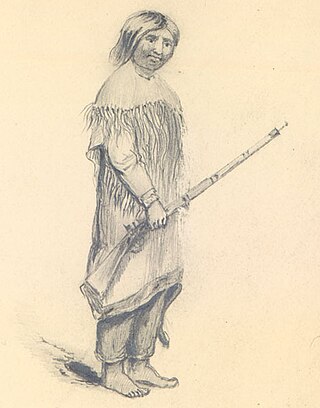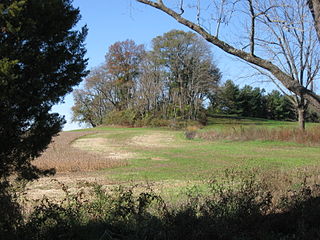
The Muscogee, also known as the Mvskoke, Muscogee Creek or just Creek, and the Muscogee Creek Confederacy, are a group of related Indigenous peoples of the Southeastern Woodlands in the United States. Their historical homelands are in what now comprises southern Tennessee, much of Alabama, western Georgia and parts of northern Florida.

Upper Saucon Township is a township in Lehigh County, Pennsylvania, United States. It is part of the Lehigh Valley metropolitan area, which had a population of 861,899 and was the 68th-most populous metropolitan area in the U.S. as of the 2020 census. The township had a population of 16,973 as of the 2020 census.

The Yakama are a Native American tribe with nearly 10,851 members, based primarily in eastern Washington state.

The Umpqua people are an umbrella group of several distinct tribal entities of Native Americans of the Umpqua Basin in present-day south central Oregon in the United States. The area south of Roseburg is now known as the Umpqua Valley.

Lenapehoking is widely translated as 'homelands of the Lenape', which in the 16th and 17th centuries, ranged along the Eastern seaboard from western Connecticut to Delaware, and encompassed the territory adjacent to the Delaware and lower Hudson river valleys, and the territory between them.

The Delaware languages, also known as the Lenape languages, are Munsee and Unami, two closely related languages of the Eastern Algonquian subgroup of the Algonquian language family. Munsee and Unami were spoken aboriginally by the Lenape people in the vicinity of the modern New York City area in the United States, including western Long Island, Manhattan Island, Staten Island, as well as adjacent areas on the mainland: southeastern New York State, eastern Pennsylvania, New Jersey, Connecticut, Maryland, and Delaware.
The Boonwurrung, also spelt Bunurong or Bun wurrung, are an Aboriginal people of the Kulin nation, who are the traditional owners of the land from the Werribee River to Wilsons Promontory in the Australian state of Victoria. Their territory includes part of what is now the city and suburbs of Melbourne. They were called the Western Port or Port Philip tribe by the early settlers, and were in alliance with other tribes in the Kulin nation, having particularly strong ties to the Wurundjeri people.

The Delaware Nation, based in Anadarko, Oklahoma is one of three federally recognized tribes of Delaware Indians in the United States, along with the Delaware Indians based in Bartlesville, Oklahoma and the Stockbridge–Munsee Community of Wisconsin. Two Lenape First Nations are in Ontario, Canada.

Unami was an Algonquian language spoken by the Lenape people in the late 17th century and the early 18th century, in the southern two-thirds of present-day New Jersey, southeastern Pennsylvania, and the northern two-thirds of Delaware. The Lenape later migrated, largely settling in Ontario, Canada and Oklahoma.

Mount Pleasant is a historic community located within the southeastern range of Mansfield Township and the northeastern range of Springfield Township, Burlington County, New Jersey. Mount Pleasant encompasses the intersection of Mount Pleasant Road and Gaunt's Bridge Road, 40°3′56″N74°40′4″W. The intersection is located about three miles (5 km) east of Columbus and one mile (1.7 km) south of Georgetown.
The Kechemeche were a Lenni Lenape tribe of Native Americans that lived in the area generally known today as the southern portion of Cape May County, New Jersey, an area bounded on one side by the Atlantic Ocean and the Delaware Bay on the other.
Netawatwees or King Newcomer was Sachem and spiritual leader of the Delaware. His name, meaning "skilled advisor" or "first in council," is spelled in a variety of ways including Netaut Twelement, Na-taut-whale-mund, Neattawatways, Netahutquemaled, and Netodwehement.
Unami Lodge, One is the Order of the Arrow (OA) lodge of the Cradle of Liberty Council, Boy Scouts of America (BSA) and the founding Lodge of the OA, having celebrated its centennial in 2015. The current Unami Lodge resulted from the 1996 merger of Unami Lodge 1 and Delmont Lodge 43, caused by the merger of Philadelphia Council and Valley Forge Council. The chiefs of each lodge agreed to preserve Unami's rich history and traditions by retaining the founding lodge's name and number. Delmont Lodge's history, including its roster of Vigil Honor, Founder's Award, and David Fortunato Outstanding Service Award recipients, is preserved as part of Unami Lodge's history. The lodge's totem is the turtle, reflecting both the name of the animal (unami) in the Delaware language, but also its association with its peoples.
Oratam was sagamore, or sachem, of the Hackensack Indians living in northeastern New Jersey during the period of early European colonization in the 17th century. Documentation shows that he lived an unusually long life and was quite influential among indigenous and immigrant populations.
Hackensack was the exonym given by the Dutch colonists to a band of the Lenape, or Lenni-Lenape, a Native American tribe. The name is a Dutch derivation of the Lenape word for what is now the region of northeastern New Jersey along the Hudson and Hackensack rivers. While the Lenape people occupied much of the mid-Atlantic area, Europeans referred to small groups of native people by the names associated with the places where they lived.
The Navesink, or Navisink, were a group of Lenape who inhabited the Raritan Bayshore near Sandy Hook and Mount Mitchill in eastern New Jersey in the United States.

The Okehocking Tribe was a small band of Unami language-speaking Delaware Indians, who occupied an area along the Ridley and Crum creeks in Delaware County, Pennsylvania. Part of that area is now known as Ridley Creek State Park. Along with the Schuylkill and Brandywine Indians, the Okehocking were known as Unami or "people down the river" by other tribes, in accordance with the Indian way of designating a tribe by geographical location.
The Dagoman are a group of Indigenous Australians living in the Northern Territory of Australia.







